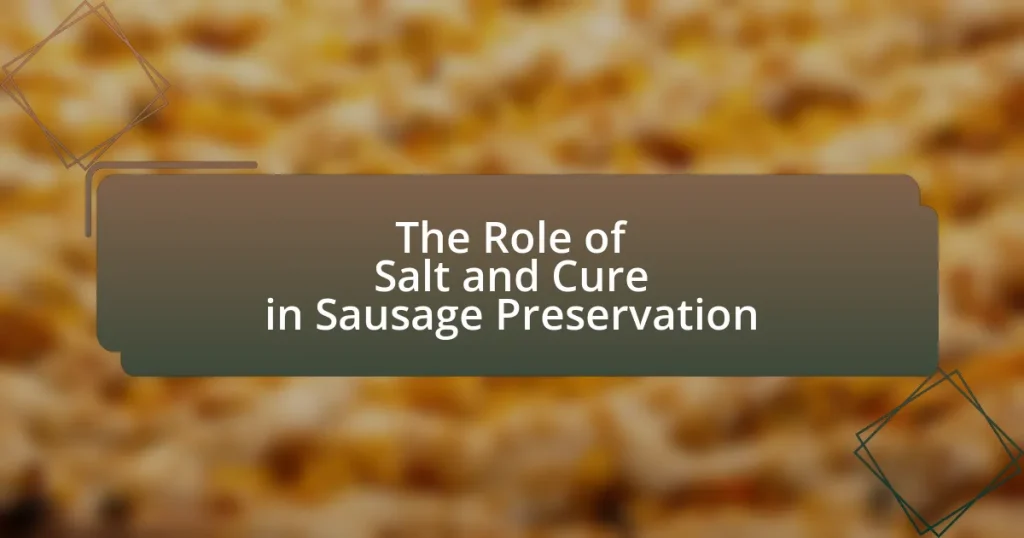The article focuses on the critical role of salt and curing agents in sausage preservation. It explains how salt inhibits microbial growth by drawing moisture out of the meat, thus preventing spoilage, while curing agents like nitrates and nitrites enhance flavor and color, and further inhibit harmful bacteria. The piece also discusses the chemical processes involved in salt preservation, the significance of achieving the right balance of salt and cure, and the historical and cultural aspects of these preservation methods. Additionally, it provides practical applications, best practices for home curing, and troubleshooting tips for ensuring effective sausage preservation.

What is the role of salt and cure in sausage preservation?
Salt and cure play a critical role in sausage preservation by inhibiting microbial growth and enhancing flavor. Salt draws moisture out of the meat, creating an environment that is less hospitable to bacteria, which helps prevent spoilage. Additionally, curing agents, such as nitrates and nitrites, not only contribute to the preservation process by further inhibiting harmful bacteria but also help develop the characteristic color and flavor of cured meats. Historical practices show that the use of salt and curing methods has been essential in extending the shelf life of sausages, with evidence dating back to ancient civilizations that relied on these techniques for food safety and storage.
How does salt contribute to the preservation of sausage?
Salt contributes to the preservation of sausage primarily by inhibiting the growth of bacteria and other microorganisms. This antimicrobial effect is due to salt’s ability to draw moisture out of the sausage, creating an environment that is less hospitable for spoilage organisms. Additionally, salt enhances the flavor and texture of the sausage while promoting the curing process, which further aids in preservation. Studies have shown that the use of salt in meat preservation dates back centuries, with historical evidence indicating that salted meats were essential for long-term storage before refrigeration was available.
What are the chemical processes involved in salt preservation?
Salt preservation primarily involves the processes of osmosis and dehydration, which inhibit microbial growth and spoilage. When salt is applied to food, it creates a hypertonic environment that draws water out of microbial cells through osmosis, leading to cell dehydration and death. This process is crucial in sausage preservation, as it reduces the moisture content, making it less hospitable for bacteria. Additionally, salt can alter the pH of the food, further inhibiting the growth of spoilage organisms. The effectiveness of salt in preservation is supported by its historical use in food preservation, where it has been shown to significantly extend shelf life by preventing spoilage and maintaining food safety.
How does salt affect the moisture content in sausage?
Salt reduces the moisture content in sausage by drawing out water through the process of osmosis. When salt is added to sausage, it creates a hypertonic environment that causes water molecules to move from the inside of the meat to the surface, thereby decreasing the overall moisture content. This reduction in moisture is crucial for preservation, as it inhibits the growth of spoilage microorganisms and enhances the shelf life of the sausage. Studies have shown that the addition of salt can lower the water activity in sausage, which is a key factor in microbial stability and food safety.
What is the significance of curing agents in sausage preservation?
Curing agents are significant in sausage preservation as they inhibit microbial growth and enhance flavor. These agents, primarily composed of salt and nitrites, create an environment that prevents spoilage and pathogenic bacteria, such as Clostridium botulinum, from thriving. The use of sodium nitrite, for example, not only preserves the meat but also contributes to the characteristic color and flavor of cured sausages. Studies have shown that the application of curing agents can extend the shelf life of sausages significantly, often by several months, while maintaining safety and quality.
What types of curing agents are commonly used in sausage making?
Curing agents commonly used in sausage making include sodium nitrite, sodium nitrate, and various types of salt. Sodium nitrite is primarily used for its ability to inhibit bacterial growth and enhance color and flavor, while sodium nitrate serves as a longer-term curing agent that converts to nitrite during the curing process. Salt, essential for flavor and preservation, also aids in moisture control and texture. These agents are critical in preventing spoilage and ensuring food safety in cured meats.
How do curing agents enhance flavor and safety in sausages?
Curing agents enhance flavor and safety in sausages by introducing specific compounds that contribute to taste and inhibit microbial growth. Sodium nitrite, a common curing agent, not only imparts a characteristic flavor but also prevents the growth of harmful bacteria such as Clostridium botulinum, which can cause botulism. Additionally, the curing process develops a desirable color and aroma through the formation of nitrosamines and other flavor compounds during cooking. Studies have shown that the use of curing agents significantly reduces the risk of foodborne illnesses while enhancing the overall sensory qualities of the sausage.
Why is the balance of salt and cure important in sausage preservation?
The balance of salt and cure is crucial in sausage preservation because it inhibits microbial growth and enhances flavor. Salt acts as a preservative by drawing moisture out of the meat, creating an environment that is less hospitable to bacteria. The curing agents, such as nitrates and nitrites, further prevent spoilage and the growth of pathogens like Clostridium botulinum. Research indicates that a salt concentration of 1.5% to 3% is optimal for effective preservation, as it not only ensures safety but also contributes to the development of desirable taste and texture in the sausage.
What are the consequences of too much or too little salt in sausage?
Too much salt in sausage can lead to excessive sodium intake, which may cause health issues such as hypertension and cardiovascular diseases. Conversely, too little salt can result in inadequate preservation, leading to spoilage and the growth of harmful bacteria, such as Clostridium botulinum, which can cause foodborne illnesses. The balance of salt is crucial for both flavor enhancement and safety in sausage production, as it inhibits microbial growth while also contributing to the overall taste profile.
How does the curing process vary between different types of sausages?
The curing process varies significantly between different types of sausages, primarily influenced by the ingredients, methods, and desired outcomes. For example, dry-cured sausages like salami undergo a fermentation process where salt and specific cultures are used to develop flavor and preserve the meat, typically requiring a longer curing time of several weeks to months. In contrast, fresh sausages, such as Italian sausage, are not cured but rather seasoned and cooked immediately, relying on refrigeration for preservation. Additionally, semi-dry sausages, like pepperoni, are cured for a shorter duration and often include a combination of curing salts and spices, resulting in a firmer texture and distinct flavor profile. These variations in curing processes are essential for achieving the unique characteristics and safety of each sausage type.

What are the historical and cultural aspects of salt and cure in sausage preservation?
Salt and cure have been essential in sausage preservation for centuries, serving both practical and cultural purposes. Historically, salt was used as a preservative due to its ability to inhibit bacterial growth, a practice documented as far back as ancient civilizations, including the Romans and Egyptians, who utilized salt to extend the shelf life of meats. Culturally, various regions developed unique sausage recipes that reflect local traditions and available resources, with salt playing a crucial role in flavor enhancement and preservation techniques. For example, in Europe, different types of cured sausages, such as Italian salami and Spanish chorizo, showcase regional spices and methods, illustrating how salt and curing processes are intertwined with cultural identity and culinary heritage.
How has the use of salt and cure evolved over time in sausage making?
The use of salt and cure in sausage making has evolved from basic preservation methods to sophisticated techniques that enhance flavor and safety. Historically, salt was primarily used to inhibit bacterial growth and extend shelf life, with ancient civilizations utilizing it for meat preservation. Over time, the introduction of curing agents like nitrates and nitrites improved the safety and color of sausages, as seen in the 19th century when these compounds became widely adopted in commercial production. Modern sausage making now incorporates a variety of curing methods, including dry curing, wet curing, and the use of starter cultures, which not only preserve but also develop complex flavors and textures, reflecting advancements in food science and technology.
What traditional methods of curing sausages are still in practice today?
Traditional methods of curing sausages that are still in practice today include dry curing, wet curing, and smoking. Dry curing involves rubbing salt and spices directly onto the meat, allowing it to draw moisture out and develop flavor over time. Wet curing, or brining, uses a saltwater solution to preserve the meat, often incorporating additional flavorings. Smoking adds both flavor and preservation through the application of smoke from burning wood, which contains natural preservatives. These methods have historical roots in various cultures and continue to be utilized for their effectiveness in enhancing flavor and extending shelf life.
How do different cultures utilize salt and cure in their sausage recipes?
Different cultures utilize salt and cure in their sausage recipes as essential methods for preservation and flavor enhancement. For instance, in Italy, salt is used in the production of salami, where it not only preserves the meat but also develops its characteristic tangy flavor through fermentation. In Germany, sausages like bratwurst and weisswurst rely on curing salts, which include sodium nitrite, to prevent bacterial growth and impart a pink color. Similarly, Spanish chorizo incorporates salt and paprika for both preservation and a distinct taste, while in Eastern European countries, salt is crucial in making smoked sausages, where the curing process enhances the meat’s longevity and flavor profile. These practices are supported by historical traditions and regional ingredients, demonstrating the universal importance of salt and curing in sausage-making across various cultures.
What role does salt play in the safety of sausage products?
Salt plays a crucial role in the safety of sausage products by inhibiting the growth of harmful bacteria, particularly pathogens like Salmonella and Listeria. The presence of salt creates an environment that reduces water activity, making it less conducive for microbial growth. Studies have shown that salt concentrations of 1.5% to 3% can significantly lower the risk of spoilage and foodborne illnesses in cured meats. Additionally, salt aids in the curing process, which involves the use of nitrites that further enhance safety by preventing botulism. Thus, salt is essential not only for flavor but also for ensuring the microbiological safety of sausage products.
How does salt inhibit the growth of harmful bacteria in sausages?
Salt inhibits the growth of harmful bacteria in sausages primarily through its ability to draw moisture out of bacterial cells, leading to dehydration and cell death. This process, known as osmosis, occurs when salt creates a hypertonic environment, causing water to move from the bacteria into the surrounding salt solution. As a result, the bacteria cannot survive or reproduce effectively. Additionally, salt can disrupt the metabolic processes of bacteria, further inhibiting their growth. Studies have shown that higher concentrations of salt can significantly reduce the viability of pathogens such as Salmonella and Listeria in meat products, confirming its effectiveness as a preservative.
What are the food safety guidelines regarding salt and curing agents?
Food safety guidelines regarding salt and curing agents emphasize proper usage to prevent foodborne illnesses. Salt acts as a preservative by inhibiting microbial growth, while curing agents, such as sodium nitrite, are used to enhance flavor and color while also preventing botulism. The USDA recommends maintaining a minimum salt concentration of 1.5% in cured meats to ensure safety. Additionally, curing agents should be used according to established limits, such as not exceeding 200 ppm of sodium nitrite in finished products, to minimize health risks. These guidelines are supported by research indicating that proper salt and curing agent application significantly reduces the risk of pathogens in meat products.

What are the practical applications and best practices for using salt and cure in sausage preservation?
Salt and cure are essential for sausage preservation, primarily by inhibiting microbial growth and enhancing flavor. The practical applications include using salt to draw moisture from the meat, which creates an environment less conducive to spoilage. Best practices involve using the correct ratio of salt to meat, typically around 1.5% to 2.5% of the meat weight, and incorporating curing agents like sodium nitrite to prevent botulism and improve color. Additionally, maintaining proper temperature and humidity during the curing process is crucial; a temperature range of 34°F to 40°F and humidity levels of 70% to 80% are recommended to ensure effective preservation. These methods are supported by food safety guidelines from organizations such as the USDA, which emphasize the importance of salt and curing agents in preventing foodborne illnesses.
What tips should be followed for effective sausage curing at home?
To effectively cure sausage at home, use the right balance of salt and curing agents, maintain proper temperature and humidity, and ensure cleanliness throughout the process. Salt is essential for drawing moisture out of the meat, which inhibits bacterial growth and enhances flavor. The ideal curing temperature ranges from 34°F to 40°F (1°C to 4°C) with humidity levels around 70% to 80% to promote the right fermentation environment. Cleanliness is crucial; all equipment and surfaces must be sanitized to prevent contamination. Following these guidelines ensures a safe and flavorful curing process.
How can one determine the right amount of salt for different sausage types?
To determine the right amount of salt for different sausage types, one should follow a guideline of 1.5% to 3% of the total meat weight, depending on the sausage style. For example, fresh sausages typically require about 1.5% salt, while cured sausages may need up to 3% to ensure proper preservation and flavor enhancement. This range is supported by food science research, which indicates that salt not only acts as a preservative by inhibiting microbial growth but also enhances the overall taste and texture of the sausage.
What are common mistakes to avoid when curing sausages?
Common mistakes to avoid when curing sausages include using insufficient salt, neglecting proper temperature control, and failing to use the correct curing agents. Insufficient salt can lead to spoilage and unsafe products, as salt is essential for inhibiting bacterial growth. Proper temperature control is crucial; curing sausages at temperatures that are too high can promote unwanted bacterial growth, while temperatures that are too low can hinder the curing process. Additionally, not using the appropriate curing agents, such as sodium nitrite, can result in inadequate preservation and potential health risks, as these agents help prevent botulism and enhance flavor.
How can one troubleshoot issues related to salt and cure in sausage preservation?
To troubleshoot issues related to salt and cure in sausage preservation, one should first assess the salt concentration and curing agents used in the recipe. Insufficient salt can lead to spoilage, while excessive salt can result in an overly salty product. It is essential to measure salt accurately, typically aiming for a concentration of 1.5% to 2.5% of the meat weight for effective preservation. Additionally, checking the curing agent’s effectiveness, such as sodium nitrite, is crucial, as improper amounts can affect color, flavor, and safety. The use of a reliable curing calculator can help ensure correct proportions. Monitoring the sausage during the curing process for signs of spoilage, such as off odors or discoloration, can also indicate issues with salt and cure.
What signs indicate that a sausage has not been properly cured?
Signs that indicate a sausage has not been properly cured include an off or sour smell, slimy texture, and discoloration. An off or sour smell suggests bacterial growth, while a slimy texture indicates spoilage due to inadequate curing. Discoloration, such as gray or green patches, can also signal that the sausage has not undergone proper preservation processes. These signs are critical as they reflect the failure of salt and curing agents to inhibit microbial activity, which is essential for safe sausage production.
How can one adjust the curing process if the sausage flavor is off?
To adjust the curing process when the sausage flavor is off, one should modify the salt concentration and the curing time. Increasing the salt concentration can enhance flavor and improve preservation, as salt is essential for flavor development and moisture control in cured meats. Additionally, extending the curing time allows for better flavor integration and development, as the curing agents have more time to penetrate the meat. Research indicates that optimal salt levels typically range from 1.5% to 3% of the meat weight, which is crucial for achieving the desired flavor profile.
